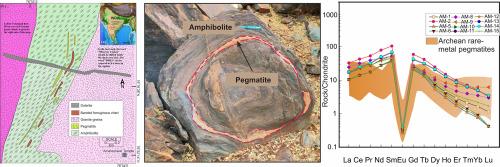Geochemical and mineralogical constraints on lithium mineralization in rare-metal pegmatites of the Amareshwar region, Eastern Dharwar Craton, India
引用次数: 0
Abstract
Around 50 percent of global lithium resources are hosted in the rare-metal pegmatites. The present study deals with whole-rock geochemistry as well as zinnwaldite mineral chemistry of rare-metal pegmatites from Amareshwar, Gurugunta schist belt, Eastern Dharwar Craton to understand the source of lithium bearing ore fluids in these pegmatites and to evaluate their mineralization potential. Detailed petrography and mineral chemistry of Amareshwar pegmatites indicate that lithium is hosted in both spodumene and zinnwaldite. The zinnwaldite mineral chemistry elucidates the incorporation of lithium in mica crystal lattice along the vector Al2(R2+)–3. The whole rock geochemical signatures suggest that these pegmatites are alkaline to calc-alkaline in nature, peraluminous and emplaced in S-type and syn-collisional tectonic setting. The chondrite normalized REE patterns are characterized by prominent negative Eu anomalies coupled with significant LREE enrichment and HREE depletion indicating fractional crystallization with plagioclase separation. Elevated concentrations of Li (Avg. = 1355 ppm), Cs (Avg. = 246 ppm), Ta (Avg. = 124 ppm), Sr (Avg. = 105 ppm) and Rb (Avg. = 2234 ppm) coupled with their geochemical characteristics classify them as LCT type of rare-metal pegmatites. The relationship between La/Ta versus Mg/Li and Zr/Hf versus Nb/Ta attest that the studied samples are lithium mineralized pegmatites of magmatic-hydrothermal origin. Extremely low ratios of Mg/Li (0.004), K/Rb (0.004), K/Cs (0.05), K/Ba (0.07), Al/Ga (0.23) fingerprint that these pegmatites have evolved from highly fractionated, fertile parental granitic magma having promising economic potential.

印度东Dharwar克拉通Amareshwar地区稀有金属伟晶岩中锂矿化的地球化学和矿物学约束
全球约50%的锂资源蕴藏在稀有金属伟晶岩中。本文对东Dharwar克拉通Amareshwar、Gurugunta片岩带稀有金属伟晶岩进行了全岩地球化学和锌walite矿物化学研究,以了解这些伟晶岩中含锂矿流体的来源,并评价其成矿潜力。阿玛列什瓦尔伟晶岩的详细岩石学和矿物化学特征表明,锂在锂辉石和锌walite中均有赋存。锌walite矿物化学解释了锂沿矢量Al2(R2+) -3在云母晶格中的掺入。整体岩石地球化学特征表明,这些伟晶岩为碱性至钙碱性,过铝质,位置于s型和同碰撞构造环境。球粒陨石归一化稀土模式的特征是显著的负Eu异常,伴随着明显的LREE富集和HREE亏缺,表明斜长石分离的分馏结晶。Li (Avg = 1355 ppm)、Cs (Avg = 246 ppm)、Ta (Avg = 124 ppm)、Sr (Avg = 105 ppm)和Rb (Avg = 2234 ppm)含量的升高,结合其地球化学特征,将其归类为LCT型稀土晶岩。La/Ta与Mg/Li、Zr/Hf与Nb/Ta的关系表明,研究样品为岩浆热液型锂矿化晶岩。极低的Mg/Li(0.004)、K/Rb(0.004)、K/Cs(0.05)、K/Ba(0.07)、Al/Ga(0.23)指纹图谱表明,这些辉晶岩是由高分馏、肥沃的母花岗质岩浆演化而来,具有广阔的经济潜力。
本文章由计算机程序翻译,如有差异,请以英文原文为准。
求助全文
约1分钟内获得全文
求助全文

 求助内容:
求助内容: 应助结果提醒方式:
应助结果提醒方式:


